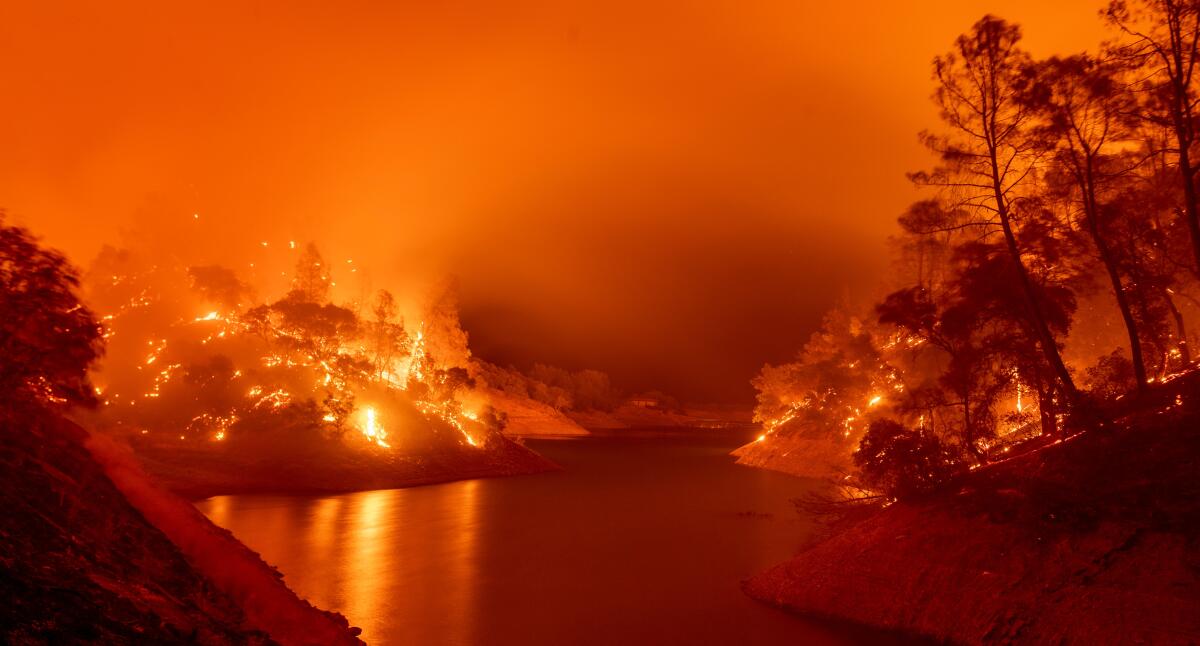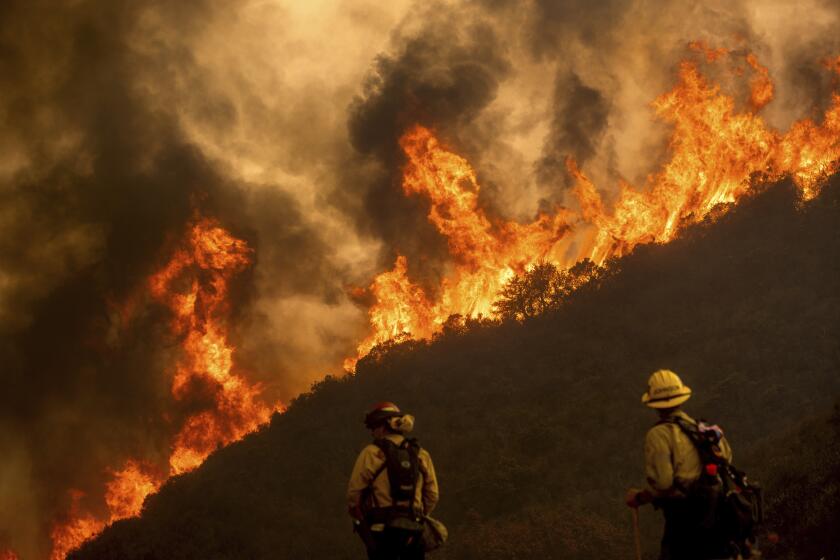In this year’s atypical California fire season, politicians find the blame game won’t work

- Share via
SACRAMENTO — This wildfire season is different. And it must be frustrating for many politicians. It certainly is for pundits. That’s because there is no one really to blame.
A cardinal rule of politics and punditry is to clearly state the problem, point out who’s at fault and say what should be done about it.
But during the current wildfires, no human apparently is at fault. It’s Mother Nature’s handiwork — mostly her lightning strikes. No mortal can turn those fire bolts off.
OK, we could prepare better for them and should.
But so far, it doesn’t seem to be Pacific Gas & Electric Co.’s fault. Unlike in past fire seasons, the utility’s old power equipment isn’t tumbling down and igniting flammable brush or dead trees it should have cleared.
There haven’t been any nutty arsonists out there that we know about. Nor careless campers who left their breakfast fires smoldering. No smokers tossing lit cigarette butts from their cars.
No, this time it’s Mother Nature’s fault.
Many scientists and public officials also cite global warming, including Gov. Gavin Newsom. They may be right. But lightning was around long before we started burning fossil fuel.
“I’m not in denial about climate change,” Newsom told reporters last week. “If you don’t believe in climate change, come to the state of California and we will educate you….
“Not just wildfires — droughts and floods. Snowpack [diminishing] and the like. I could go on.”
Newsom’s predecessor, four-term Gov. Jerry Brown, was a fatalist about wildfires.
The California Legislature abandoned a bill to extend a fee on utility customers to generate $500 million for wildfire projects.
While inspecting devastation from Butte County’s cataclysmic Camp fire in 2018, Brown was asked by a reporter, “How do we curb these fires?”
“You know,” Brown answered, “we’ve had fires for long before the Europeans showed up here. And our Indigenous people had a different way of living with nature. For 10,000 years, there were never more than 300,000 [people in California]. Now we have 40 million and we have a totally different situation.
“So it’s not one thing. It’s people. It’s how people live, it’s where they live and it’s the changing climate…. And the truth is … we’re going to have more difficulties,” he said. “Things are not going to get better. They’re going to get more challenging because of the continuing alternation in the climate … lack of moisture, early snowmelt and faster winds, the whole thing.”
Unquestionably we need to slow global warming. But to do that we need a U.S. president who doesn’t think climate change is a socialist hoax.
Whatever we Californians and all Americans do to wean ourselves off fossil fuel, however, it isn’t going to stop wildfires for the foreseeable future.
Stephen J. Pyne, a professor emeritus at Arizona State University who specializes in environmental history, put it this way in a recent Times opinion piece:
“Until we began binge-burning fossil fuels, we had managed to live with fire. We need to relearn how to coexist with it because it isn’t going away — it can’t. Unlike for COVID-19, no fire vaccine is possible.
“At this point in our fire-powered warming world, even as we ratchet down fossil fuel burning, landscape fires will likely ratchet up…. We can ready ourselves to truly manage fire or scramble in blustering incredulity,” he wrote. “But the fires are coming.”
The August lightning strikes, however, were freakish and relatively rare.
Lightning like that doesn’t happen every season. In one three-day span, there were 12,000 lightning strikes in California — an average of 167 an hour.
“That’s an unusual amount of lightning,” says Nick Schuler, deputy chief at the California Department of Forestry and Fire Protection.
As Southern Californians increasingly flock to the mountains for relief from a recent heat wave and months-long coronavirus restrictions, hundreds of illegal campfires have sprung up in dispersed campsites.
Other big lightning bursts came in 2008 and 1987, Schuler says. But this year’s was bigger than both of those. And this summer, the vegetation is especially flammable because of an abnormally dry winter.
President Trump habitually accuses California Democrats of failing to clear the forests of dead trees and brush that fuel fires. Newsom “has done a terrible job of forest management,” the Republican president claims.
That’s typical Trump. The federal government owns and manages 57% of California’s 33 million acres of forests. The state owns only 2.2% and local governments less than 1%. Private landowners have about 40%. The feds should clean up their own mess.
No argument, California governments and private landowners all have been irresponsibly tardy in clearing out fire-fueling brush and dead timber. The state government has been trying to catch up during the last three years. It has cleaned up 90,000 acres. That’s a good start, but it’s just a small stick of kindling compared with what’s out there ready to burn.
Forest cleaning should be a top state priority and it apparently is. There are plans to annually reduce fire fuel on 1 million acres in partnership with the federal government.
Newsom, Brown and legislators deserve credit for recently hopping to it on firefighting and prevention.
They’ve purchased 12 twin-engine Black Hawk helicopters retrofitted for firefighting, replacing old Vietnam War-era single-engine Huey birds. The Black Hawks fly faster and can dump more water.
Cal Fire has added 13 new fire engines and 858 more firefighters — plus a lot of new technology such as wildfire alert cameras.
Since Newsom took office, the state has spent about $500 million beefing up Cal Fire.
As of Friday, 14,600 firefighters — state, local and federal — using 2,400 fire engines and more than 100 aircraft were battling more than two dozen major blazes.
The state’s long-term solution: Keep doing what it’s doing — only much more of it.
More to Read
Sign up for Essential California
The most important California stories and recommendations in your inbox every morning.
You may occasionally receive promotional content from the Los Angeles Times.














